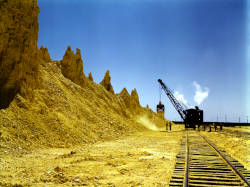Sulfur Mines

Sulphur is an element which forms yellow crystals in its pure form. Sulphur forms a variety of compounds. Therefore, although sulphur is the 16th most common element in the lithosphere, it is relatively rare in elemental form. It is most frequently found in connection with volcanism, because it has a fairly low melting and evaporation point, and the volcanic heat causes its evaporation. Anyone who has visited such phenomena knows the characteristic smell. The most prominent use of sulphur is in black powder, in which it is one of the three main components. However, this is hardly relevant nowadays as black powder has long been replaced by other explosives. Much more important is its use in rubber products, for the vulcanisation of rubber.
Sulphur is extracted in four ways. The simplest is in places where it volcanically outgasses. The sulphur gas cools down quickly and the sulphur condenses, forming deposits of very pure sulphur. These are mined by hand and often carried on the back to civilisation, in many developing countries this extraction method still exists. However, it is of no industrial interest because the deposits are usually too small and the volcanism too unpredictable. Secondly, there are sulphur deposits where sulphur was deposited from volcanic sources over a long period of time in the past. These can also be mined on a large scale. Afterwards, the sulphur must be dissolved from the rock, typically by heating and liquefying it. Historically, this was done by burning some sulphur, but this both consumes sulphur and pollutes the environment with sulphurous acid. Many deposits of metal ores contain sulphur compounds, for example pyrite (FeS2) as iron ore. During smelting, the sulphur is released, but with suitable processes it can be extracted, so that many sulphur-bearing ore deposits also produce sulphur in addition to the metals. And finally, the fourth possibility is to recover sulphur from the exhaust gas of power stations, waste incineration plants or industrial plants. Due to the low price of sulphur, this is usually not cost-covering, but in most industrialized countries it is enforced by environmental protection laws. A simple method is to bind it with lime, which is converted into gypsum. Gypsum is a raw material.
We have very few sulphur mines listed on showcaves.com, so they are all the more interesting. Sulphur mines were rare, partly because there are few deposits, but also because there are so many other possibilities. As well as the traditional method of mining as rock followed by heating, the process can be reversed. In this case, sulphur deposits are exploited using the Frasch method developed by Hermann Frasch. Superheated water is pumped into the deposit through a borehole, the sulphur liquefies and is brought to the surface by injected air. This method is relatively modern, and as recently as the 1990s, 3.1 million tonnes were extracted annually in this way. Today there is no longer any such mining, for one thing, suitable deposits are rare, and for another, the energy costs and environmental problems are immense.
Another important factor is that sulphur is not really needed that urgently, sulphuric acid is much more important. And this is often much easier to extract than elementary sulphur.
- Examples
 Miniera di Zolfo Cabernardi, Italy
Miniera di Zolfo Cabernardi, Italy Parco Minerario Floristella Grottacalda, Italy
Parco Minerario Floristella Grottacalda, Italy Kristinebergs gruva, Sweden
Kristinebergs gruva, Sweden
 Search DuckDuckGo for "Sulfur Mine"
Search DuckDuckGo for "Sulfur Mine" Sulfur - Wikipedia
Sulfur - Wikipedia
 Index
Index Topics
Topics Hierarchical
Hierarchical Countries
Countries Maps
Maps